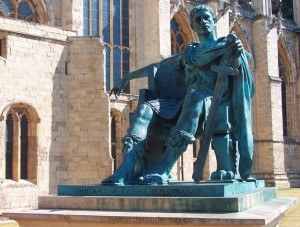Sitting near York Minster in England is the statue of Constantine shown below. Notice the contemplative look on Constantine’s face as he examines his sword. You’d think he’d never really seen it before! Why? Look again, at where the tip of the sword should rest on the ground. As you can see, the tip of his sword is broken off. Although the sword could still cut, it’s utility as a weapon is pretty much gone. It is a cross now, the great symbol of God’s self-gift of life rather than an instrument of death.
 I work around a lot of folks, including pacifists, who are uniformly horrified by the thought of carrying a weapon. And yet, there’s one weapon they carry with them, as do most of us: our sharp, savage tongues. The propensity of the human tongue to cause trouble was not missed by observers as shrewd as the biblical authors. The sages, prophets and psalmists all recognized the damage that the tongue can do. But for my money it’s James that has the most vivid imagery: the tongue is an untameable member, a fire ignited by hell itself, a “restless evil, full of deadly poison” (Ja 3:6-8). Poison is a nasty weapon for many reasons but one particularly reprehensible quality is that once released it cannot be controlled, that is, it does not distinguish between lawful combatants and those who are simply in the wrong place at the wrong time. And so it is with what we say: poison is a most apt description.
I work around a lot of folks, including pacifists, who are uniformly horrified by the thought of carrying a weapon. And yet, there’s one weapon they carry with them, as do most of us: our sharp, savage tongues. The propensity of the human tongue to cause trouble was not missed by observers as shrewd as the biblical authors. The sages, prophets and psalmists all recognized the damage that the tongue can do. But for my money it’s James that has the most vivid imagery: the tongue is an untameable member, a fire ignited by hell itself, a “restless evil, full of deadly poison” (Ja 3:6-8). Poison is a nasty weapon for many reasons but one particularly reprehensible quality is that once released it cannot be controlled, that is, it does not distinguish between lawful combatants and those who are simply in the wrong place at the wrong time. And so it is with what we say: poison is a most apt description.
Too bad we can’t just cut off the tips of our tongues, so to speak, and change them from deadly weapons to a source of life. We’d probably all be as bemused as Constantine at the results.
Mogs











